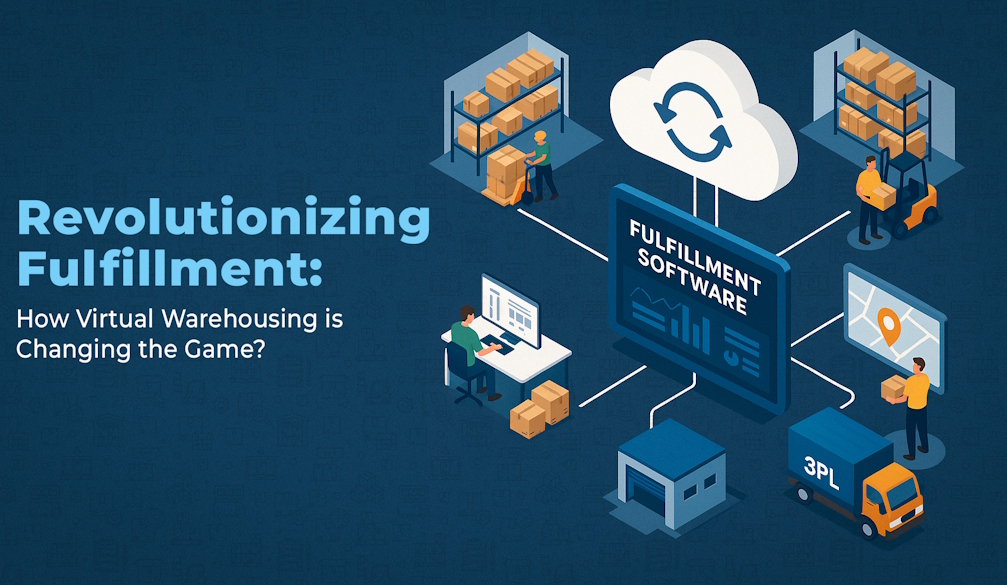Revolutionizing Fulfillment: How Virtual Warehousing is Changing the Game?

The e-commerce landscape is evolving more rapidly than ever, and the way businesses are managing their fulfillment is also revolutionizing. At the core of this change is Fulfillment Management Software, which empowers companies to optimize operations while keeping pace with an increasingly tech-driven marketplace. A game-changer in this space has been the rise of virtual warehousing, which is modernizing the way businesses manage inventory, boost efficiency, and meet customer expectations across multiple sales channels.
Virtual warehousing is no longer a marketing terminology or a future concept. With virtual warehousing projected to become a vast USD 88.4 billion market by 2033, a new era in logistics and fulfillment is emerging. Being powered by cloud-based 3PL Warehouse Management Systems (WMS) and order fulfillment software, this seismic approach makes smarter yet flexible logistics accessible and affordable for businesses of all sizes.
What Is Virtual Warehousing?
Virtual warehousing isn’t about making inventory magically disappear. Instead, it’s a smart, strategic approach that connects a network of geographically spread storage locations, often managed by third-party logistics providers (3PLs), under a single centralized digital platform. In simple terms, it’s a cloud-based software that lets businesses manage their inventory and fulfill orders digitally without having to depend on a single, physical warehouse space.
Let’s say you’re having several smaller warehouses placed close to your customers, but without the complexity or cost of owning and operating each building yourself. Virtual warehousing makes that possible by synchronizing inventory in real-time across all locations. This lets your business operate as if it has one large, unified warehouse, digitally connected but physically spread out.
Why Virtual Warehousing Matters Now?
There are numerous factors driving towards virtual warehousing. Some of them are:
-
* The boom of online shopping demands quick fulfillment and streamlined inventory across every sales channel.
-
* Today’s consumer craves total transparency, real-time access to availability, and faster deliveries than ever.
-
* Labor, storage ,and transportation costs are escalating, increasing the importance of efficiency and cost control.
-
* Companies are struggling to deal with market volatility at very short notice, dealing with last-minute order rushes, seasonality, and supply chain disruption, making it necessary to have a more flexible operational style.
-
* With the advent of cloud computing, AI, IoT, automation, you can now optimally run a complex, geographically disbursed network of warehouses.
How Virtual Warehousing Works?
1. Real-Time Inventory Visibility
Are you still relying on guesswork and wondering where your stock is? Those days of guessing are over now. An integrated 3PL WMS and fulfillment software provides you with a 360-degree live view of inventory from all your warehouse locations and bonded partner locations.This cuts down on mistakes, avoids stockouts and prevents excessive inventory.
2. Smart & Automated Order Routing
AI-based systems automatically direct customer orders to the nearest best warehouse, typically the warehouse closest to the customer or with stock available. This shortens the distance and lowers shipping cost, and involves zero manual intervention.
3. Multichannel Integration
Virtual warehousing helps to synchronise inventory management across all your sales channels, including your website, Amazon, Shopify, physical store, etc, to avoid the risk of overselling and maintain uniform shopper experience.
4. Partner & 3PL Network Collaboration
By tapping into third-party logistics networks on-demand, virtual warehousing scales fulfillment capacity without hefty upfront capital investments in physical infrastructure.
5. Data Analytics & Demand Forecasting
Advanced insights from data enable smarter decisions by optimizing stock placement, anticipating demand spikes, and automating replenishment or warehouse transfers to maintain uninterrupted operations and maximize efficiency.
How Virtual Warehousing Solves Your Biggest Fulfillment Challenges?
1. High Shipping Costs and Slow Deliveries
Warehousing costs can eventually lead to costly expedited shipping just to satisfy customer needs. Virtual warehousing positions inventory closer to customers, allowing affordable ground shipping and expedited delivery options (such as 2-day or same-day delivery) that don’t break the bank.
2. Limited Scalability and Flexibility
Physical warehouses are set with capacities and expensive times to grow. In contrast, virtual warehousing enables you to instantly scale up and down using a network of partner warehouses, making it easier to deal with seasonal spikes or fluctuations in demand.
3. Lack of Inventory Visibility and Control
Without centralized data, stock can be skewed causing lost sales or overstock related costs. Advanced 3PL WMS solutions for virtual warehousing can offer a real-time, 360-degree view cross cross-location visibility, so you know exactly what you’ve got and where you’ve got it.
4. Complexity Managing Multiple Logistics Partners
Managing shipments across multiple warehouses, carriers and fulfilment centres can be a huge headache on your operations. Virtual warehousing streamlines this process by bringing communication and workflow together in one place and allowing your team to concentrate on business expansion.
The Human Element: Empowering Teams with Technology
The technology is crucial, but we must never forget the human component. The aim is not to replace employees but to enable them with next-gen tech-driven tools and softwares.By automating the mundane, repetitive tasks such as data entry and inventory checks, virtual warehousing also lets your team concentrate on more valuable work, like innovation, interacting with the customer and continuous improvement. This consistent, accelerated fulfillment fosters loyalty and trust among customers, converting one-time customers into repeat customers.
Key Benefits of Virtual Warehousing
-
* Better visibility and control over highly distributed stock and operations.
-
* Saving on costs by lowering stocks in warehouse and optimizing transport routes.
-
* More responsive, high-quality fulfillment through automation and intelligent order routing.
-
* Agile and scalable operations that can easily adapt to market needs.
-
* Increased customer satisfaction with reliable, timely, and transparent deliveries.
-
* Stronger risk management by diversifying inventory storage to reduce disruption impact.
Looking Ahead: The Future of Fulfillment is Virtual
Virtual warehousing isn’t a fleeting trend, it’s the backbone of tomorrow's supply chain. This advanced technology delivers greener fully-connected data-driven logistics networks with AI, cloud computing, IoT technologies and rich smart data analytics. Companies that embrace virtual warehousing can swiftly and easily scale into new markets, customize fulfillment, lower their carbon footprint, and keep up with the demanding expectations of today’s customer.
Ready to Revolutionize Your Fulfillment?
If you’re still relying on manual spreadsheets or outdated warehouses, it’s time to think about virtual warehousing. With the help of next-gen 3PL warehouse management systems and fulfillment management software, you can drive down costs, maximize speed and delivery,gain control, and scale your operations dynamically.
.







